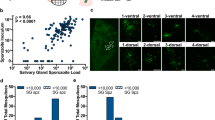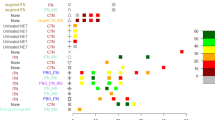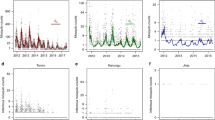Abstract
Malaria is an important cause of global morbidity and mortality. The fact that some people are bitten more often than others has a large effect on the relationship between risk factors and prevalence of vector-borne diseases1,2,3. Here we develop a mathematical framework that allows us to estimate the heterogeneity of infection rates from the relationship between rates of infectious bites and community prevalence. We apply this framework to a large, published data set that combines malaria measurements from more than 90 communities4. We find strong evidence that heterogeneous biting or heterogeneous susceptibility to infection are important and pervasive factors determining the prevalence of infection: 20% of people receive 80% of all infections. We also find that individual infections last about six months on average, per infectious bite, and children who clear infections are not immune to new infections. The results have important implications for public health interventions: the success of malaria control will depend heavily on whether efforts are targeted at those who are most at risk of infection.
This is a preview of subscription content, access via your institution
Access options
Subscribe to this journal
Receive 51 print issues and online access
$199.00 per year
only $3.90 per issue
Buy this article
- Purchase on Springer Link
- Instant access to full article PDF
Prices may be subject to local taxes which are calculated during checkout

Similar content being viewed by others
References
Dietz, K. Models for vector-borne parasitic diseases. Lecture Notes Biomath. 39, 264–277 (1980)
Dye, C. & Hasibeder, G. Population dynamics of mosquito-borne disease: effects of flies which bite some people more frequently than others. Trans. Soc. Trop. Med. Hyg. 80, 69–77 (1986)
Woolhouse, M. E. et al. Heterogeneities in the transmission of infectious agents: implications for the design of control programs. Proc. Natl Acad. Sci. USA 94, 338–342 (1997)
Hay, S. I., Guerra, C. A., Tatem, A. J., Atkinson, P. M. & Snow, R. W. Urbanization, malaria transmission, and disease burden in Africa. Nature Rev. Microbiol. 3, 81–90 (2005)
Hay, S. I., Guerra, C. A., Tatem, A. J., Noor, A. M. & Snow, R. W. The global distribution and population at risk of malaria: past, present and future. Lancet Infect. Dis. 4, 327–336 (2004)
Snow, R. W., Guerra, C. A., Noor, A. M., Myint, H. Y. & Hay, S. I. The global distribution of clinical episodes of Plasmodium falciparum malaria. Nature 434, 214–217 (2005)
Murray, C. J. L. & Lopez, A. D. Alternative projections of mortality and disability by cause 1990–2020: Global burden of disease study. Lancet 24,1498–1504 (1997)
Jamison, D. T., Creese, A. & Prentice, T. World Health Report, 1999: Making a Difference (World Health Organization, Geneva, 1999)
Snow, R. W. & Gilles, H. M. in Essential Malariology 4th edn (eds Warrell, D. A. & Gilles, H. M.) Ch. 5, 85–106 (Arnold, London, 2002)
Snow, R. W. & Marsh, K. The consequences of reducing transmission of Plasmodium falciparum in Africa. Adv. Parasitol. 52, 235–264 (2002)
Macdonald, G. The Epidemiology and Control of Malaria (Oxford Univ. Press, London, 1957)
Ross, R. The Prevention of Malaria (John Murray, London, 1911)
Nájera, J. A. A critical review of the field application of a mathematical model of malaria eradication. Bull. World Health Organ. 50, 449–457 (1974)
Smith, D. L., Dushoff, J. & McKenzie, F. E. The risk of a mosquito-borne infection in a heterogeneous environment. PLoS Biol. 2, e368 (2004)
Takken, W. & Knols, B. G. J. Odor-mediated behaviour of Afrotropical malaria mosquitoes. Annu. Rev. Entomol. 44, 131–157 (1999)
Hethcote, H. W. & Yorke, J. A. In Lecture Notes in Biomathematics Vol. 56, 1–105 (Springer, Berlin, 1984)
Walton, G. A. On the control of Malaria in Freetown, Sierra Leone. I. Plasmodium falciparum and Anopheles gambiae in relation to malaria occurring in infants. Ann. Trop. Med. Parasitol. 41, 380–407 (1947)
Dietz, K., Molineaux, L. & Thomas, A. A malaria model tested in the African savannah. Bull. World Health Organ. 50, 347–357 (1974)
Aron, J. L. & May, R. M. in Population Dynamics and Infectious Disease (ed. Anderson, R. M.) Ch. 5, 139–179 (Chapman and Hall, London, 1982)
Bailey, N. T. J. The Biomathematics of Malaria (Oxford Univ. Press, Oxford, 1982)
McKenzie, F. E., Sirichaisinthop, J., Miller, R. S., Gasser, R. A. & Wongsrichanalai, C. Jr Dependence of malaria detection and species diagnosis by microscopy on parasite density. Am. J. Trop. Med. Hyg. 69, 372–376 (2003)
R Development Core Team. R: A Language and Environment for Statistical Computing (R Foundation for Statistical Computing, Vienna, Austria, 2004); http://www.R-project.org.3-900051-07-0
Beier, J. C., Killeen, G. F. & Githure, J. I. Short report: entomologic inoculation rates and Plasmodium falciparum malaria prevalence in Africa. Am. J. Trop. Med. Hyg. 61, 109–113 (1999)
Burnham, K. P. & Anderson, D. A. Model Selection and Multimodel Inference: A Practical Information-Theoretic Approach 2nd edn (Springer, New York, 2002)
Eyles, D. E. & Young, M. D. The duration of untreated or inadequately treated Plasmodium falciparum infections in the human host. J. Nat. Malaria Soc. 10, 327–336 (1951)
Gu, W. et al. Low recovery rates stabilize malaria endemicity in areas of low transmission in coastal Kenya. Acta Trop. 86, 71–81 (2003)
Sama, W., Killeen, G. & Smith, T. Estimating the duration of Plasmodium falciparum infection from trials of indoor residual spraying. Am. J. Trop. Med. Hyg. 70, 625–634 (2004)
Bagster Wilson, D. Rural hyperendemic malaria in Tanganyika Territory. Trans. R. Soc. Trop. Med. Hyg. 29, 583–618 (1936)
Molineaux, L. & Gramiccia, G. The Garki Project (World Health Organization, Geneva, 1980)
Acknowledgements
We thank D. Bradley, B. Grenfell, F. E. McKenzie, W. Prudhomme, S. Randolph, M. Recker, D. Rogers and L. Waller for comments and suggestions. We also thank the NCEAS working group for discussion. S.I.H. is funded by a Research Career Development Fellowship from the Wellcome Trust. R.W.S. is a Wellcome Trust Senior Research Fellow and acknowledges the support of the Kenyan Medical Research Institute (KEMRI). This work was partially conducted as part of the Environment and Disease Working Group supported by the National Center for Ecological Analysis and Synthesis, a Center funded by NSF, the University of California Santa Barbara, and the State of California. The views presented in this Letter represent the personal views of the authors and do not construe or imply any official position or policy of the Fogarty International Center, National Institutes of Health, Department of Health and Human Services, or the US government. Author Contributions S.I.H. collated the data. D.L.S. designed and conducted the analysis. D.L.S., J.D., S.I.H. and R.W.S. wrote the paper.
Author information
Authors and Affiliations
Corresponding author
Ethics declarations
Competing interests
Reprints and permissions information is available at npg.nature.com/reprintsandpermissions. The authors declare no competing financial interests.
Rights and permissions
About this article
Cite this article
Smith, D., Dushoff, J., Snow, R. et al. The entomological inoculation rate and Plasmodium falciparum infection in African children. Nature 438, 492–495 (2005). https://doi.org/10.1038/nature04024
Received:
Accepted:
Issue Date:
DOI: https://doi.org/10.1038/nature04024
This article is cited by
-
The Role of Historical Malaria in Institutions and Contemporary Economic Development
Studies in Comparative International Development (2023)
-
Evidence for a role of Anopheles stephensi in the spread of drug- and diagnosis-resistant malaria in Africa
Nature Medicine (2023)
-
Outdoor biting and pyrethroid resistance as potential drivers of persistent malaria transmission in Zanzibar
Malaria Journal (2022)
-
Herd immunity under individual variation and reinfection
Journal of Mathematical Biology (2022)
-
Household and individual level risk factors associated with declining malaria incidence in Meghalaya, India: implications for malaria elimination in low-endemic settings
Malaria Journal (2021)
Comments
By submitting a comment you agree to abide by our Terms and Community Guidelines. If you find something abusive or that does not comply with our terms or guidelines please flag it as inappropriate.



